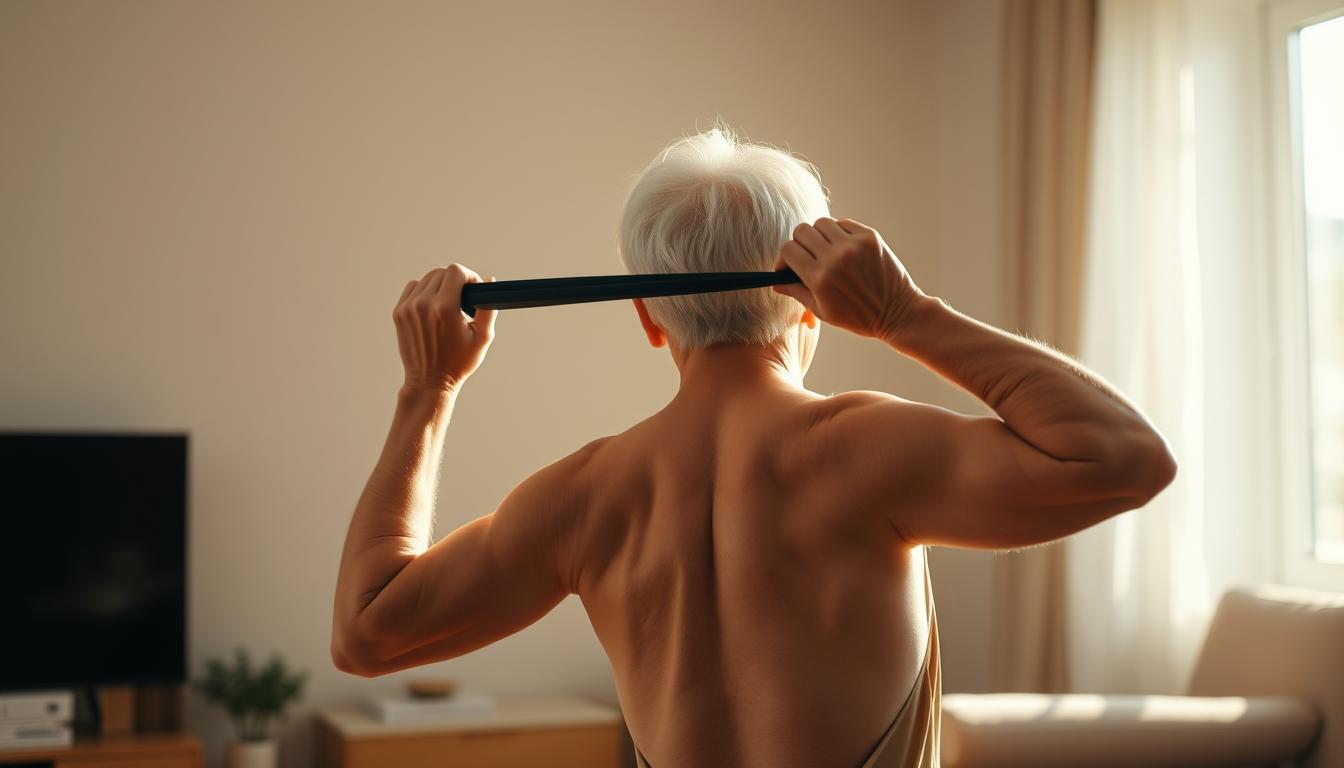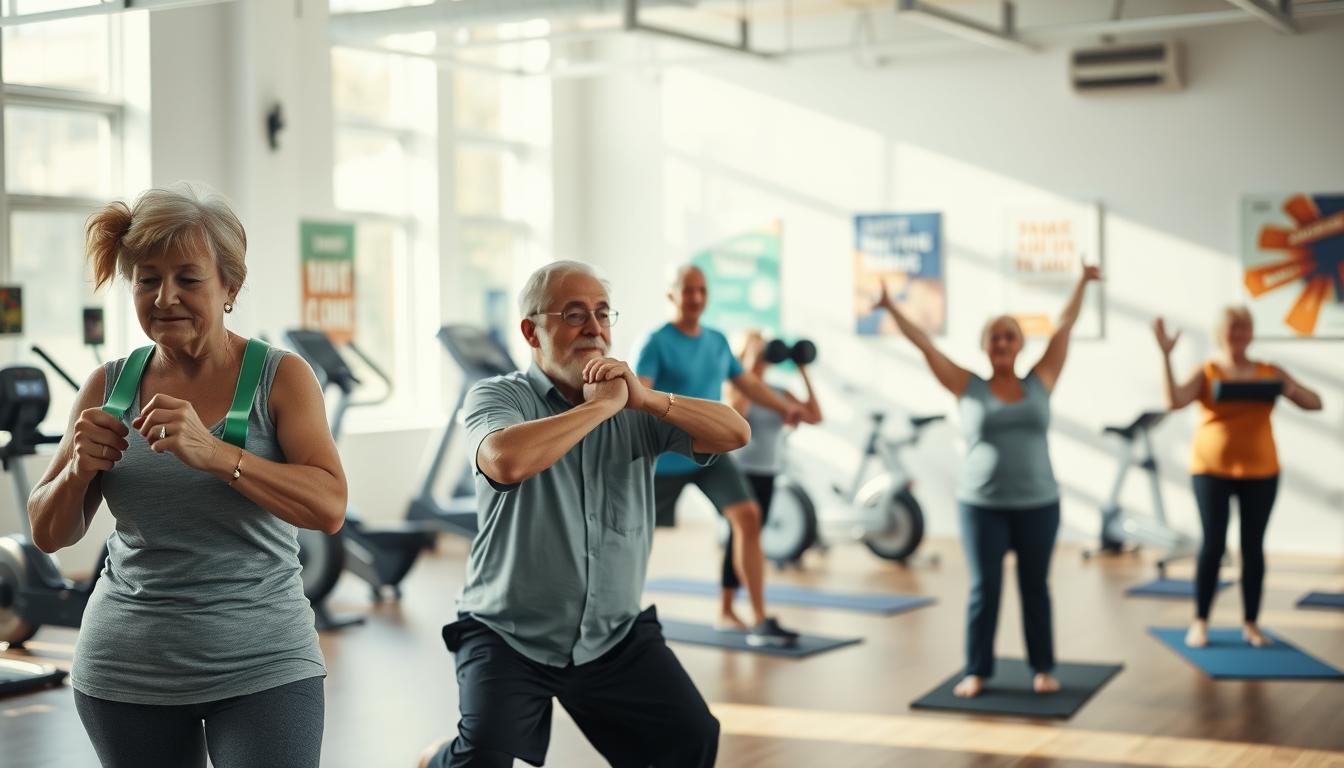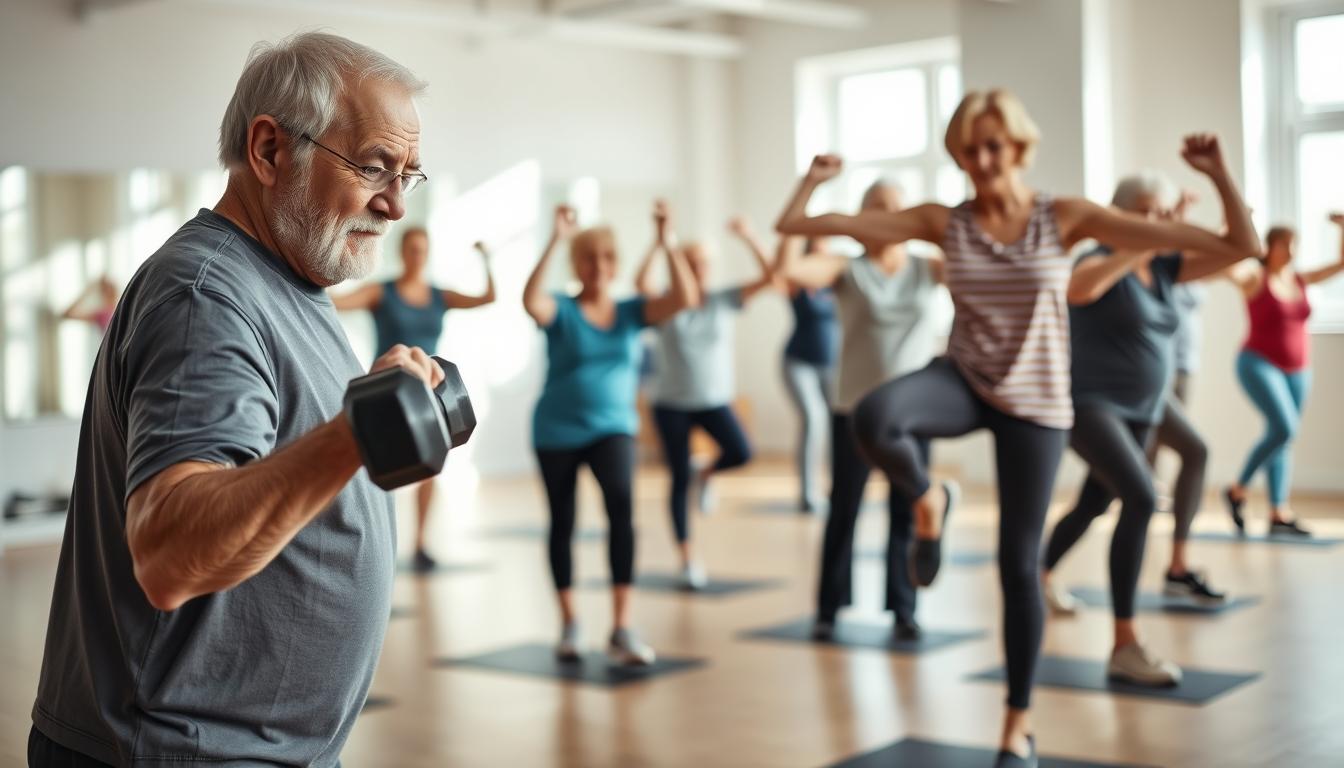Want to ease that nagging stiffness when you stand up? I’ve been there—here’s how simple movements can rebuild strength without fancy equipment. Let me show you what worked when my own spine started feeling like a rusty hinge.
These routines are designed for older adults who’ve traded yoga mats for practicality. I learned the hard way: using your kitchen chair (yes, that one) and focusing on controlled motions beats complicated gym routines. SilverSneakers nailed it with their seated pelvic tilts—slow, deliberate shifts that wake up forgotten muscles.
Here’s the kicker: keeping your soles flat on the floor while doing them matters more than reps. I once ignored this and spent a week walking like a penguin. Trust me—form trumps everything.
Consistency turns these moves into game-changers. Three mornings a week, I do 10 minutes of spine-friendly stretches. Now I pick up my grandkids without doing the “old man groan.” Your posture will thank you, too—stronger muscles mean standing taller than your tomato plants.
Ready to ditch the Advil shuffle? Let’s break down the exact steps I use daily, straight from proven programs that prioritize safety over sweat.
The Science Behind a Resilient Back
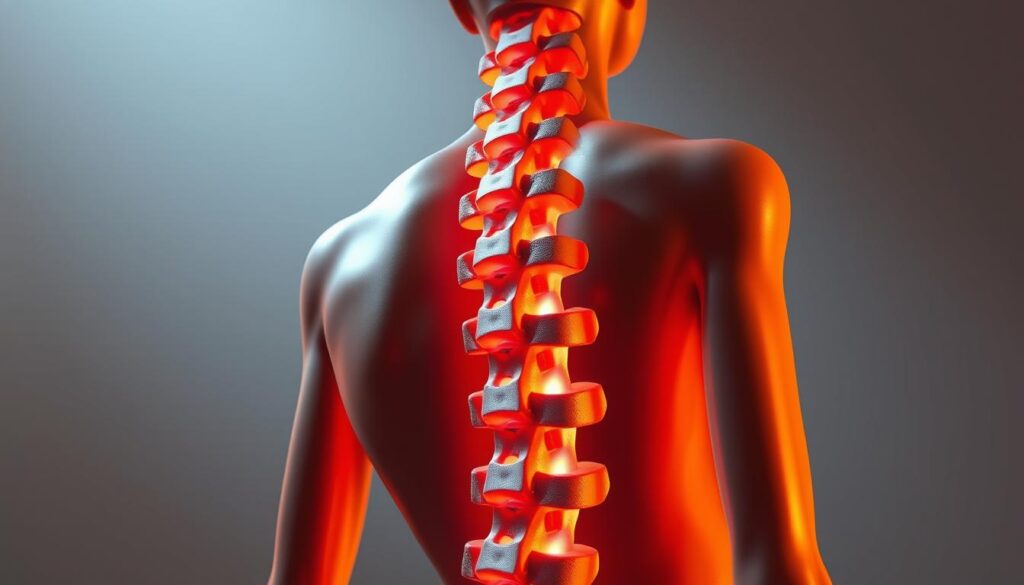
Your spine’s support system works like wooden beams in a house—when the framework weakens, everything creaks. After 60, we lose 3-5% of muscle mass yearly. Those beams? They’re shrinking faster than a wool sweater in hot water.
Understanding Age-Related Back Changes
Muscle fibers thin like overused rubber bands. Sarcopenia—that sneaky thief—steals protein synthesis, leaving your posture slouched like a sunflower after frost. Research shows 40% of older adults can’t lift 10 pounds without strain. Remember reaching for that cereal box? That’s your multifidus muscles waving white flags.
Everyday Impacts on Mobility and Flexibility
Bending to tie shoes becomes a tactical mission. SilverSneakers data proves 15 minutes daily of targeted moves cuts injury risks by half. One member told me she could suddenly grab her grandkid’s runaway soccer ball—without doing the “ouch shuffle.”
| Activity | Sedentary Seniors | Active Seniors |
|---|---|---|
| Standing from chair | 3.2 seconds | 1.8 seconds |
| Balance duration | 8 seconds | 22 seconds |
| Pain-free bending | 34% | 71% |
Here’s the kicker: muscles have memory. Start simple routines today, and in 6 weeks, your body rediscovers movements it forgot. My neighbor went from groaning when gardening to doing victory dances with her zucchini harvest. Your turn?
Back Strengthening Exercises for Seniors: Step-by-Step Tutorial
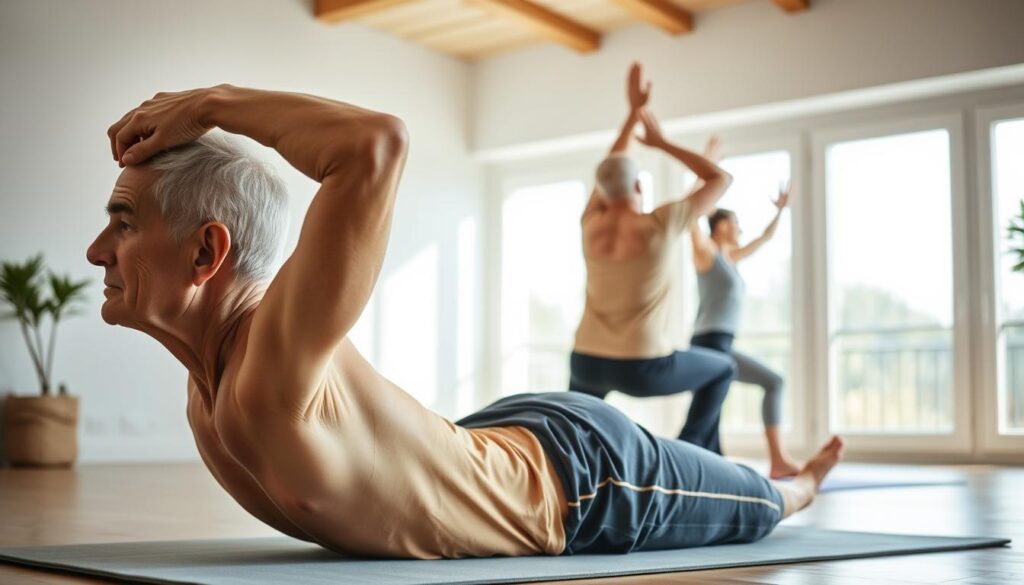
Remember that time you tried grabbing the TV remote behind the couch? Let’s turn those awkward reaches into smooth motions. I’ll walk you through two game-changing moves my physical therapist cousin swears by.
Stand Tall, Bend Smart
Stand facing your kitchen counter—yes, that’s your new gym. Follow these steps:
- Plant your soles like they’re glued to linoleum (that’s feet flat floor territory)
- Grip the edge lightly, knees softer than week-old bread
- Arch your spine upward slowly—imagine lifting a teacup with your shoulder blades
- Hold for 3 Mississippis, then return starting position like you’re reversing a VHS tape
Do 8 reps. If your hips start singing show tunes, you’re doing it right.
Chair Power: Seated Pulls
Grab resistance bands—or that stretchy belt from your robe. Sit like you’re waiting for grandkid’s recital:
- Wrap the band around sturdy chair legs
- Pull handles toward your ribs like starting a lawnmower
- Squeeze shoulder blades together—pretend you’re cracking a walnut
- Release slower than molasses in January back to starting position
| Movement | Muscles Worked | Beginner Tip |
|---|---|---|
| Standing Arch | Lower spine | Use wall for balance |
| Seated Pull | Upper back | Start with towel resistance |
| Core Activation | Abdominal support | Breathe out during effort |
My neighbor Marge combined these for 6 weeks. Now she texts me videos of her doing air guitar moves pain-free. Consistency beats intensity—three 10-minute sessions weekly work better than heroics.
Techniques for Proper Form and Safety
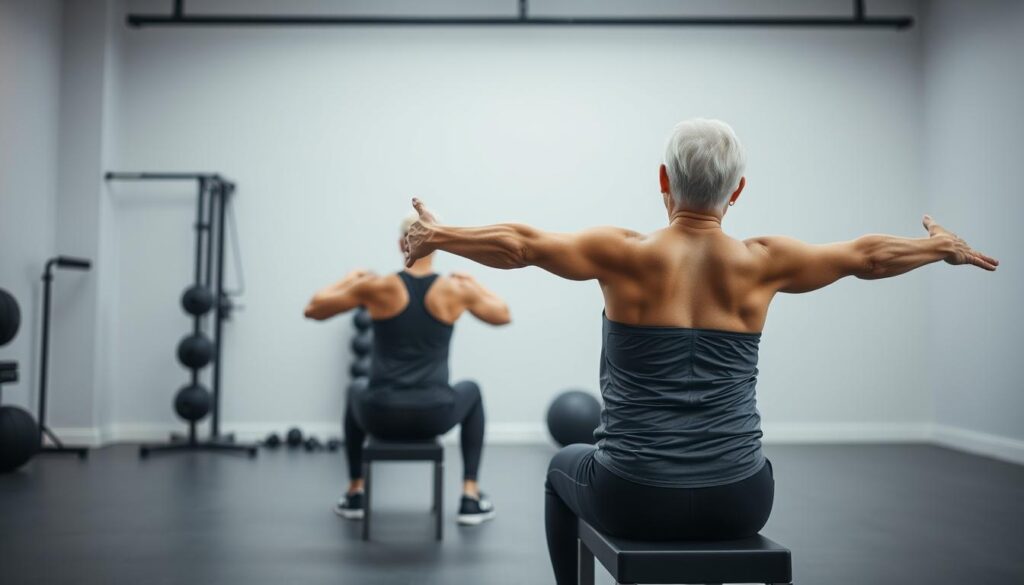
Let’s talk about how to move without sounding like a popcorn machine. Proper form isn’t just about looking good—it’s your armor against strains. I learned this the hard way when I ignored alignment and spent days icing my hips. SilverSneakers coaches hammer this point: safety beats speed every time.
Feet Flat on the Floor, Back Straight—No Shortcuts Here
Imagine your soles are suction cups. That’s how glued they should stay during movements. Slouching? Nope. Keep your spine straighter than a librarian’s ruler. When I skip this, my knees bent turn into popcorn kernels—snap, crackle, ouch.
Shoulders shoulder-width apart create a stable base. Think of it as building a human tripod. My neighbor Bob once hunched like a question mark during seated rows. He couldn’t scratch his own back for a week. Don’t be Bob.
- Return starting position slowly—like rewinding a cassette tape
- Right foot slightly forward? That’s your secret stability hack
- Knees bent at 90 degrees protect joints better than bubble wrap
| Proper Form | Risky Move | Fix |
|---|---|---|
| Feet flat | Toes lifted | Press heels down |
| Back straight | Rounded spine | Engage core muscles |
| Shoulders aligned | Hunching forward | Roll shoulders back |
Here’s the truth: slight shifts in posture can improve posture or wreck it. Last month, I adjusted my chair height by two inches. Suddenly, those seated pulls felt smoother than jazz. Your body notices details—treat it like a finicky houseguest.
Customizing Your Routine for Lasting Strength
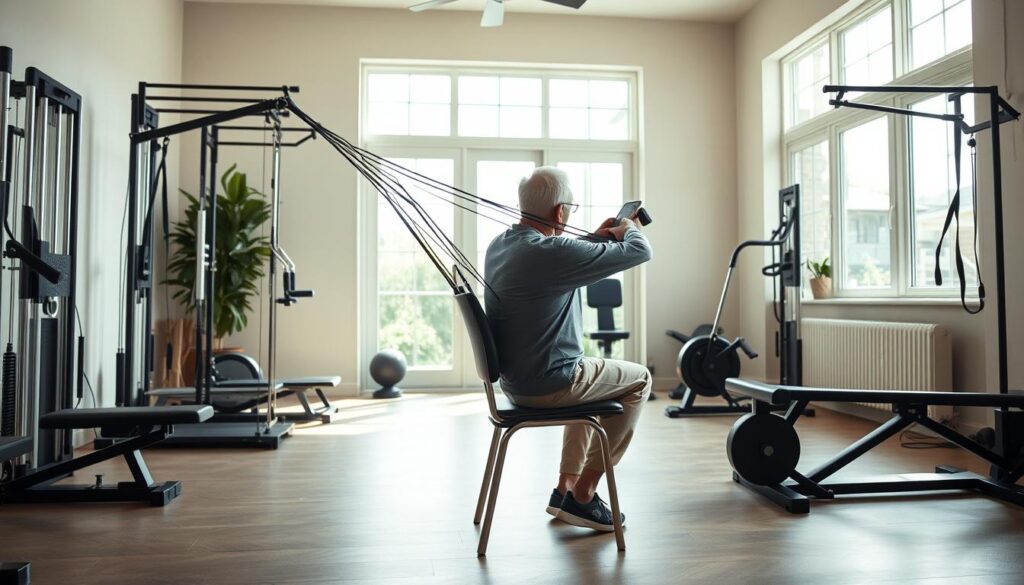
Ever tried squeezing into your grandkid’s jeans from high school? That’s how your spine feels in a one-size-fits-all routine. SilverSneakers coaches agree: personalization turns good workouts into lifelong habits. Let’s make these moves fit your body—not the other way around.
Tweaking Exercises to Match Your Pace
Resistance bands feeling too intense? Swap them for dish towels. Can’t keep feet flat on the floor? Slide a phone book under your heels. My friend Edna uses her walker as support during standing rows—genius hack that helps seniors stay steady.
Real-Life Adjustments That Work
Struggling with seated pulls? Try these tweaks:
- Rotate palms facing upward to reduce shoulder strain
- Stand hip-width apart near a wall for instant balance support
- Shorten your range of motion—think nodding “yes” instead of full head turns
| Standard Move | Modified Version | Benefit |
|---|---|---|
| Full spinal twist | Half-range rotation | Protects discs |
| Standing rows | Leaning on countertop | Improves back stability |
| Floor bridges | Pillow under hips | Reduces pressure |
Wisdom From the Mat
Martha, 78, swears by placing hands on her upper back during stretches: “It’s like having a spotter.” Retired coach Ray insists on exhaling during effort—his secret to pain-free movement. Their golden rule? “If it feels like punishment, you’re doing it wrong.”
Remember: position changes everything. Shift your weight slightly forward during lifts. Angle toes outward when standing. These micro-adjustments improve back function more than marathon sessions. Your routine should fit like a favorite sweater—snug but never restrictive.
Wrapping It Up: Maintaining a Strong Back Daily
Ever noticed how a well-oiled gate swings smoothly? Your spine craves that same daily care. SilverSneakers regulars know the secret: tiny efforts compound. I’ve seen 82-year-olds outpace millennials in posture contests by doing two things—showing up and keeping it simple.
Here’s the magic: alignment is everything. Knees over ankles, hips square like a picture frame, hands guiding movement like a conductor’s baton. My neighbor Lou starts each morning pressing his palms flat on the kitchen floor—not to clean, but to awaken his entire body. “Feels like rebooting a computer,” he grins.
That’s where the real victory lies—blending motions into life. Arm reaches while waiting for coffee. Leg lifts during commercials. One client uses her grandbaby’s naptime for wall-assisted stretches. “Started with three reps,” she told me. “Now I’m the human jungle gym.”
Your turn? Experiment. Swap chair heights. Adjust foot positions. Discover what makes your body hum. Progress hides in corners you’ve yet to peek around—ready to find it?
